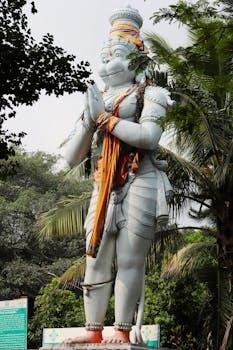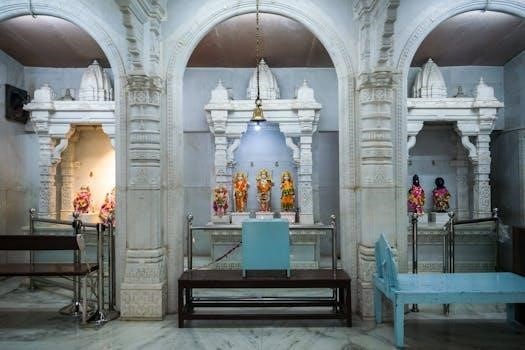The Hanuman Chalisa is a revered Hindu devotional hymn dedicated to Lord Hanuman. This sacred text, composed of forty verses, is a popular prayer recited by millions of devotees. It praises Hanuman’s strength, devotion, and service to Lord Rama.
Significance of Hanuman Chalisa in Hinduism
The Hanuman Chalisa holds immense significance within Hinduism, serving as a potent source of spiritual solace and strength. Devotees believe that reciting this hymn with devotion can bring about positive changes in their lives, removing obstacles and bestowing blessings. The Chalisa is not merely a prayer; it is a powerful tool for connecting with Lord Hanuman, considered the epitome of devotion, courage, and loyalty. The verses capture Hanuman’s divine qualities, inspiring devotees to emulate his virtues and seek his protection. It’s a practice that fosters faith, enhances spiritual well-being, and provides comfort during times of adversity. The regular recitation of the Chalisa is thought to generate positive energy and invoke Hanuman’s presence, thereby creating a shield against negative influences. It is a cornerstone of Hindu devotional practices.
Author and Composition of Hanuman Chalisa
The Hanuman Chalisa is attributed to the revered saint and poet Goswami Tulsidas, a significant figure in Hindu literature. Tulsidas, known for his devotion to Lord Rama and his masterful storytelling, composed the Chalisa in the Awadhi language, a dialect of Hindi. The work is part of a larger body of devotional literature that includes the Ramcharitmanas. The Chalisa, comprising forty verses praising Lord Hanuman, is a concise yet comprehensive depiction of his virtues and divine powers. Tulsidas crafted the verses with simple language and rhythmic structure, making it accessible to all. His intention was to provide a means for devotees to connect with Hanuman and seek his blessings. The authorship adds to the Chalisa’s revered status, ensuring its widespread adoption in Hindu practices.

Availability of Hanuman Chalisa PDF in Hindi
The Hanuman Chalisa is widely available in PDF format in Hindi. This accessibility allows devotees to easily download and read or print the sacred text for their use.
Free Download Options for Hindi PDF
Numerous websites offer free downloads of the Hanuman Chalisa in Hindi PDF format, making it readily accessible to devotees worldwide. These platforms often host various versions of the Chalisa, including those with clear text and high-quality layouts suitable for printing. Many resources provide direct links to download the PDF files from cloud storage services, ensuring a quick and easy process. Additionally, some websites feature options for both Hindi and English versions, accommodating a wider range of users. It is common to find PDF versions that are specifically formatted for optimal reading on different devices, including smartphones, tablets, and computers. These free options allow individuals to engage with the sacred text without any cost, promoting wider access to this important Hindu devotional hymn. Many sites also offer options to download the text with or without images.
High-Quality PDF Formats
High-quality PDF formats of the Hanuman Chalisa in Hindi are widely available for those seeking a pristine reading experience. These formats often feature clear, crisp text with traditional fonts that enhance readability and visual appeal. Many of these high-quality PDFs are designed to be printer-friendly, ensuring that the text remains sharp and legible when printed. Some versions might also include beautifully rendered images of Lord Hanuman, adding to the devotional ambiance. These PDFs are carefully formatted to preserve the layout and structure of the text, making it easier for devotees to follow along. Furthermore, high-quality files tend to be optimized for quick downloads without compromising on the quality of the content. Such formats cater to the needs of those who value a well-presented version of this sacred text. Some sources also offer different page layouts depending on the intended use, such as single-page or booklet formats.
Direct Download Links
Direct download links for Hanuman Chalisa PDFs in Hindi are readily accessible across various online platforms. These links provide a straightforward way to obtain the desired document without navigating through multiple pages. You can often find these links on websites dedicated to Hindu scriptures, religious forums, and personal blogs that share devotional content. Many sources offer multiple options, including different file sizes and formats, to cater to diverse needs. These direct links ensure a quick and easy way to download the PDF, saving time and effort. It’s advisable to always download from trusted sources to avoid any malicious software or incorrect versions of the text. Usually these links will be clearly visible and easy to click, making the process user-friendly, and often the file will download immediately after clicking; Some sites also offer the option to preview the file before downloading, which can be helpful in verifying the content and layout.

Content and Structure of the Hanuman Chalisa
The Hanuman Chalisa is structured with forty verses, known as ‘chaupais,’ preceded by two introductory dohas and concluded with a final doha. It praises Hanuman’s virtues and deeds.
Meaning of ‘Chalisa’ and Number of Verses
The term “Chalisa” originates from the Hindi word “chalis,” which translates to forty. This nomenclature directly reflects the composition of the Hanuman Chalisa, as it comprises exactly forty verses or ‘chaupais’. These forty verses, along with the initial and concluding couplets known as ‘dohas,’ form the complete structure of the hymn. The significance of the number forty is not merely a coincidence; it is deeply rooted in Hindu tradition. In this context, the forty verses are dedicated to extolling the virtues, powers, and devotion of Lord Hanuman. Each verse serves as a powerful invocation, narrating his legendary deeds and qualities; The consistent use of ‘chaupais’ provides a rhythmic flow, making the hymn easy to memorize and recite. This structure facilitates the devotional practice and enhances the spiritual experience for the reciter.
Key Themes and Praises of Lord Hanuman
The Hanuman Chalisa is rich with themes that highlight Lord Hanuman’s exemplary qualities. Devotion to Lord Rama is a central theme, emphasizing his unwavering loyalty and selfless service. The verses extol Hanuman’s immense strength, courage, and wisdom, portraying him as the embodiment of physical and spiritual power. His role as a protector and vanquisher of evil is also prominently featured. Many verses praise Hanuman for his ability to overcome obstacles and bring solace to devotees. The hymn celebrates his humility, despite his great abilities. Furthermore, the Chalisa emphasizes his role as a messenger, a divine being who bridges the gap between the human and divine realms. The praises underscore Hanuman’s virtues, making him a role model for devotees seeking strength, devotion, and liberation.
The Dohas and Chaupais
The Hanuman Chalisa is structured with distinct poetic forms, primarily the dohas and chaupais. The dohas, which are couplets, often serve as introductory or concluding verses, setting the tone and summarizing the essence of the hymn. The chaupais, which are quatrains, form the main body of the Chalisa, narrating Hanuman’s divine qualities and heroic deeds. Each chaupai typically consists of four lines, creating a rhythmic and lyrical flow that aids in recitation and memorization. The interplay between dohas and chaupais enhances the musicality and impact of the text. This structure allows for a systematic progression of praises and ensures that devotees can easily follow the narrative. The repetition of patterns within these verses makes the Chalisa not only a powerful prayer, but also a beautiful piece of devotional literature that is easy to engage with.

Benefits of Reciting Hanuman Chalisa
Reciting the Hanuman Chalisa is believed to provide spiritual strength and blessings. Devotees often experience peace, courage, and protection from negative energies through this practice. It is a source of solace.
Spiritual and Astrological Significance
The Hanuman Chalisa holds deep spiritual significance within Hinduism, acting as a powerful tool for devotion and inner transformation. Reciting it is believed to invoke Lord Hanuman’s divine presence, bestowing blessings of strength, courage, and protection from negative influences. From an astrological perspective, chanting the Chalisa is considered beneficial in mitigating the malefic effects of planets, especially Saturn. Many believe it helps alleviate obstacles, resolve conflicts, and bring about positive changes in one’s life. The verses are seen as vibrational keys that unlock spiritual growth and enhance mental clarity. Regular recitation is a practice that fosters a deeper connection with the divine, promoting peace and harmony within individuals and their surroundings. The Chalisa’s profound impact is not merely limited to the present but also extends to one’s spiritual journey.
Devotional Practices and Blessings
Devotees often incorporate the Hanuman Chalisa into their daily devotional practices, finding solace and inspiration in its verses. Reciting the Chalisa, either alone or in groups, is a common ritual performed at home, in temples, and during festivals. Many believe that consistent recitation, especially at dawn or dusk, brings about a sense of peace and strengthens their faith; It is also customary to read the Chalisa while facing an image or idol of Lord Hanuman, further enhancing the devotional experience. The blessings derived from this practice are numerous, including increased courage, wisdom, and devotion. It is believed that by surrendering to Hanuman through the Chalisa, one can overcome life’s challenges and attain spiritual liberation. Devotees often experience a sense of protection and divine grace through this regular practice.
Hanuman Chalisa as a Source of Strength
The Hanuman Chalisa serves as a powerful source of strength and courage for its reciters. Many devotees turn to it during times of adversity, seeking solace and empowerment from the mighty Lord Hanuman. The hymn’s verses are filled with descriptions of Hanuman’s immense strength, unwavering devotion, and his ability to overcome any obstacle. By reciting the Chalisa, individuals can tap into this energy and find the inner resolve to face their own challenges. It is believed that the hymn instills a sense of fearlessness and resilience, helping devotees to navigate difficult situations with grace and fortitude. Furthermore, the Chalisa acts as a reminder of Hanuman’s unwavering faith and commitment, inspiring individuals to uphold their own values and beliefs, thereby finding strength in their own convictions. The words provide mental and spiritual support.

Related Devotional Compositions
Besides the Hanuman Chalisa, other devotional texts like the Bajrang Baan and the 108 names of Hanuman are significant. These compositions offer diverse ways to connect with Lord Hanuman.
Bajrang Baan and its Comparison to Hanuman Chalisa
The Bajrang Baan, another potent hymn dedicated to Lord Hanuman, is often compared to the Hanuman Chalisa. While the Chalisa is a more general praise and prayer, the Bajrang Baan is specifically a plea for protection and the removal of obstacles. The Bajrang Baan is known for its direct and forceful invocation, seeking immediate intervention from Hanuman. Unlike the Chalisa’s forty verses, the Bajrang Baan has a different structure, focusing on specific requests for divine aid. While both texts are powerful devotional tools, the Bajrang Baan is often recited for urgent needs, while the Chalisa is a regular practice for overall well-being and devotion. Both texts hold immense significance in Hindu culture, and both are frequently available in PDF format for devotees to easily access and recite, especially in Hindi.
108 Names of Hanuman and Their Significance
The 108 names of Lord Hanuman, also known as the Hanuman Ashtottara Shatanamavali, are a significant part of Hindu devotional practices. Each name represents a different aspect, quality, or achievement of Lord Hanuman. Chanting these names is considered highly meritorious and is believed to invoke Hanuman’s blessings. These names are not directly related to the Hanuman Chalisa, which is a separate composition with its specific structure and purpose. However, both the Chalisa and the recitation of the 108 names are devoted to the same deity. The 108 names serve as a powerful tool for devotees to connect with Hanuman on a deeper level, meditating on his numerous divine attributes. These names are often available in PDF format for easy access and chanting, and the PDFs often include their meanings.
